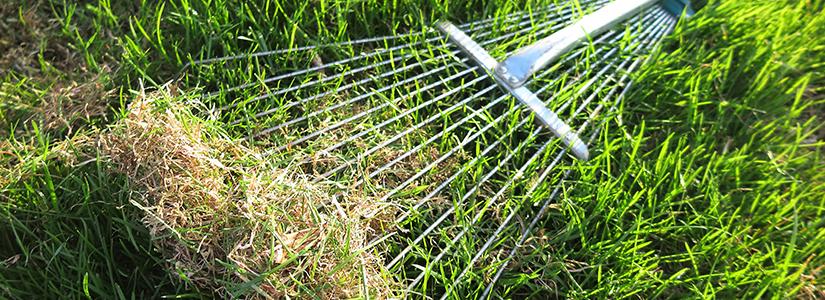Most home owners never know if they have a thatch problem or not – until their lawn looks like this!
What is thatch? It’s the dense, fibrous layer of living and dead grass shoots, stems, leaves and roots that accumulates between the green vegetation and the soil surface.
A thin layer, ½ inch (12.7 mm) or less, is desirable. It helps moderate temperature extremes, limits weed growth, and provides cushioning that makes an excellent surface for play and sports.
However, too much can result in an insect infestation or disease. A too-thick thatch layer can prevent grass roots from growing deep into the soil, making the entire grass plant more vulnerable to stressors. A thick thatch layer also may block the penetration of water and nutrients into the soil.
To determine if your lawn has a problem, remove a 4 to 6 inch (10.16 to 15.24 cm) plug of turf. Squeeze the spongy layer of thatch between your fingers. If the layer approaches ¾ inch (19.05 mm) when squeezed, you’ll want to dethatch.
You can rent dethatching equipment or hire a professional. There are several names for effective dethatching equipment: vertical mowers, verticutters, dethatchers or power rakes. All of these have sturdy, vertically-spinning blades which pull some of the material to the surface as they slice the thatch layer.
Some other types of dethatching equipment, with flexible tines similar to those of a leaf rake, are far less effective. For example, spring tines, designed to attach to the blade of a rotary mower for dethatching, are ineffective and may damage your mower.
Mechanical dethatching for all types of grass should be done in either late summer or fall when the grass is well-established and actively growing and cool weather prevails.
Do not dethatch when the lawn is wet because you can damage the equipment.
Don’t attempt to remove the entire thatch layer with one pass over the lawn. Cover the area from north to south; then use a leaf rake to remove the organic material that has been dislodged. Repeat this process, covering the lawn from east to west.
You can compost the organic material that you have collected.
Grass clippings do not cause thatch and they are good for your lawn. When mowing, it is recommended that you leave the clippings on your lawn to provide nutrients for the grass and the soil.
Source: The Lawn Institute
Contact Us
"*" indicates required fields

